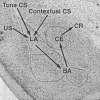Contextual and auditory fear conditioning are mediated by the lateral, basal, and central amygdaloid nuclei in rats
- PMID: 11390634
- PMCID: PMC311374
- DOI: 10.1101/lm.37601
Contextual and auditory fear conditioning are mediated by the lateral, basal, and central amygdaloid nuclei in rats
Abstract
A large body of literature implicates the amygdala in Pavlovian fear conditioning. In this study, we examined the contribution of individual amygdaloid nuclei to contextual and auditory fear conditioning in rats. Prior to fear conditioning, rats received a large electrolytic lesion of the amygdala in one hemisphere, and a nucleus-specific neurotoxic lesion in the contralateral hemisphere. Neurotoxic lesions targeted either the lateral nucleus (LA), basolateral and basomedial nuclei (basal nuclei), or central nucleus (CE) of the amygdala. LA and CE lesions attenuated freezing to both contextual and auditory conditional stimuli (CSs). Lesions of the basal nuclei produced deficits in contextual and auditory fear conditioning only when the damage extended into the anterior divisions of the basal nuclei; damage limited to the posterior divisions of the basal nuclei did not significantly impair conditioning to either auditory or contextual CS. These effects were typically not lateralized, although neurotoxic lesions of the posterior divisions of the basal nuclei had greater effects on contextual fear conditioning when the contralateral electrolytic lesion was placed in the right hemisphere. These results indicate that there is significant overlap within the amygdala in the neural pathways mediating fear conditioning to contextual and acoustic CS, and that these forms of learning are not anatomically dissociable at the level of amygdaloid nuclei.
Figures






References
-
- Amorapanth P, LeDoux JE, Nader K. Different lateral amygdala outputs mediate reactions and actions elicited by a fear-arousing stimulus. Nature Neurosci. 2000;3:74–79. - PubMed
-
- Canteras NS, Swanson LW. Projections of the ventral subiculum to the amygdala, septum, and hypothalamus: A PHAL anterograde tract-tracing study in the rat. J Comp Neurol. 1992;324:180–194. - PubMed
-
- Coleman-Mesches K, McGaugh JL. Differential effects of pretraining inactivation of the right or left amygdala on retention of inhibitory avoidance training. Behav Neurosci. 1995;109:642–647. - PubMed
Publication types
MeSH terms
Substances
Grants and funding
LinkOut - more resources
Full Text Sources
